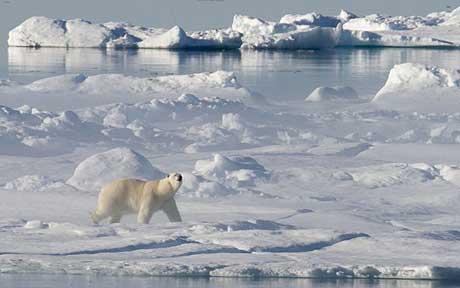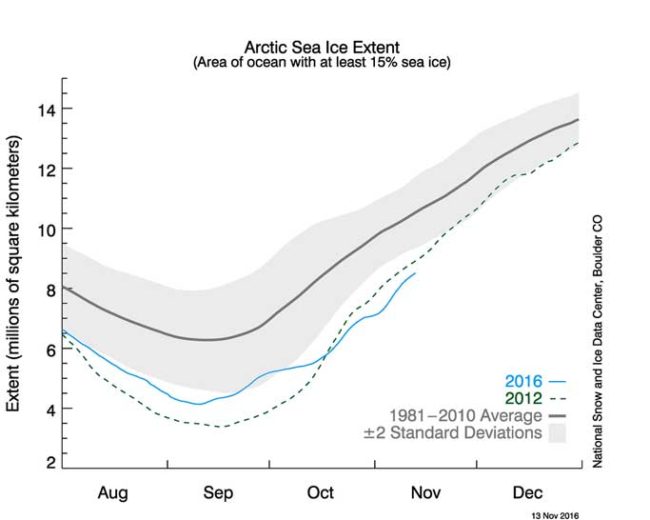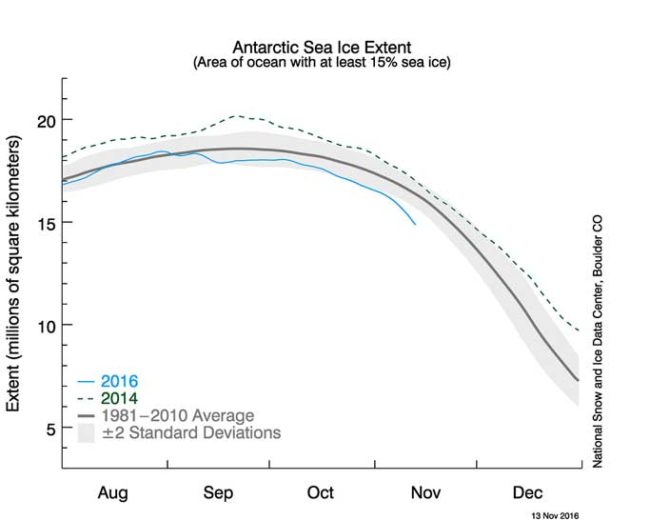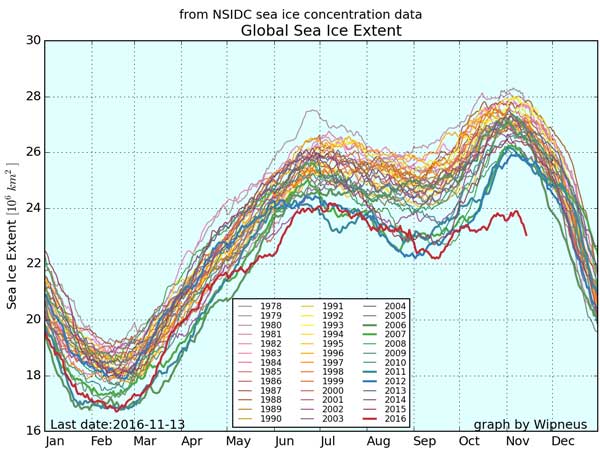 As we roll through the months the quantity of Arctic sea ice will of course follow natural seasonal variations. In recent decades it has been observed that it is very much in decline overall, but to some degree this Arctic sea ice loss has been balanced out by a corresponding gain of sea ice in the Antarctic, hence overall globally it has followed a fairly predictable and stable curve.
As we roll through the months the quantity of Arctic sea ice will of course follow natural seasonal variations. In recent decades it has been observed that it is very much in decline overall, but to some degree this Arctic sea ice loss has been balanced out by a corresponding gain of sea ice in the Antarctic, hence overall globally it has followed a fairly predictable and stable curve.
This is now no longer true, something dramatic has happened.
In the Arctic
Right now we are at an all time low for this time of year in the Arctic. The diagram below, which is updated on a daily basis via satellite measurements, and is available via the National Snow and Ice Data Center, reveals that in about the middle of October the quantity of sea ice in the Arctic dropped to an all time low for this time of year and is now sustaining that all-time low with each passing day.
A primary culprit behind the slow growth is that sea surface temperatures in the Beaufort and Chukchi Seas, the Barents and Kara Seas along the Eurasian coast, as well as the East Siberian Sea, were above average. The open water areas in the highest latitudes at the date of the minimum in September had only recently formed and there was little input of solar radiation so far north. So those waters were just above the freezing point. When the atmosphere cooled in September, ice formed rapidly. However, further south, the sea ice had retreated far earlier in the season and a lot of solar energy was absorbed through the summer. This ocean heat inhibited the growth of ice in these regions. Finally toward the end of October, the surface ocean heat began to dissipate, triggering ice formation. However, even by October 25, sea surface temperatures were above average in these areas.
However, the what is perhaps most important on-going observation in the Arctic is that the Arctic is losing it’s oldest and thickest multi-year ice.
NASA has a nice animation that illustrates this …
One significant change in the Arctic region in recent years has been the rapid decline in perennial sea ice. Perennial sea ice, also known as multi-year ice, is the portion of the sea ice that survives the summer melt season. Perennial ice may have a life-span of nine years or more and represents the thickest component of the sea ice; perennial ice can grow up to 4 meters thick. By contrast, first year ice that grows during a single winter is generally at most 2 meters thick.
This animation shows the Arctic sea ice age for the week of the minimum ice extent for each year, depicting the age in different colors. Younger sea ice, or first-year ice, is shown in a dark shade of blue while the ice that is 5 or more years old is shown as white. A color scale identifies the age of the intermediary years. A bar graph displayed in the lower right corner quantifies the area covered by the ice in each age category on the day of the annual minimum. In addition, memory bars shown in green portray the maximum annual value for each age range seen since Jan. 1, 1984, on the day of the annual minimum.
Most of the old ice is now gone. In the 1980s, multi-year ice made up 20 percent of the sea ice cover. Now it’s only about 3 percent.
“The older ice was like the insurance policy of the Arctic sea ice pack: as we lose it, the likelihood for a largely ice-free summer in the Arctic increases.”
Ah but Arctic ice loss usually gets balanced out by globally by ice growth in Antarctic, so is that still the case?
Hint … No.
In the Antarctic
Flip the coin to the other side of the planet, and we now observe more ice loss. The quantity of sea ice is at a low for this time of year …
After a reaching its maximum extent unusually early and then following a period of relatively unchanging overall extent, Antarctic sea ice extent started to decline in earnest. Daily sea ice extent levels have been at second lowest in the satellite record …
…The rapid early reduction in sea ice cover in this region may create favorable conditions for the break up of the eastern Peninsula ice shelves at the end of austral summer.
Global Sea Ice
Put all of this together, chart it going back many years, and suddenly something extraordinary leaps out …
That red line is 2016.
Side note: The above chart uses the NSIDC data, but is not on their website, it can be found here – https://sites.google.com/site/arctischepinguin/home/sea-ice-extent-area/grf (Hat tip to Wipneus)
As previously mentioned, there has been an on-going observation that as Arctic sea ice shrank, the Antarctic sea ice grew and that kept the quantity of global sea ice at a predictable constant that did of course vary over the months (see chart above) but generally remained on the same curve when you compared different years. That however is now no longer true.
We should perhaps also briefly ponder on one question that some may ask. If indeed the world was warming globally, then why was the Antarctic sea ice growing?
The prevailing thinking regarding why the Antarctic sea ice was growing was the hypothesis that as melting fresh water flowed off the Antarctic glaciers into the ocean it froze. Since fresh water has a higher freezing temperature than sea water, this enabled the sea ice to expand. We may now have reached a point where this effect stops for the moment.
So what does this all mean?
Clearly we are rapidly heading towards an ice free Arctic summer and will be there in about (puts finger in the air for a conservative estimate) 8-12 years or sooner.
That is quite frankly astonishing.
Previously a 2006 paper predicted “near ice-free September conditions by 2040”. Previously IPCC AR5 was suggesting 2050, so something a lot sooner is a big surprise.
What we also have is a feedback loop. Rather obviously white ice reflects sunlight back off the planet, and when that declines you have replaced it with darker ocean that then absorbs the energy into the ocean instead of reflecting it. Less ice and earlier melting enables more energy to enter the system, and so instead of small gradual incremental seasonal changes due to increased greenhouse gases, we have sudden dramatic change such as that now being observed.
2016 is a year like no other, and not just for political reasons.



